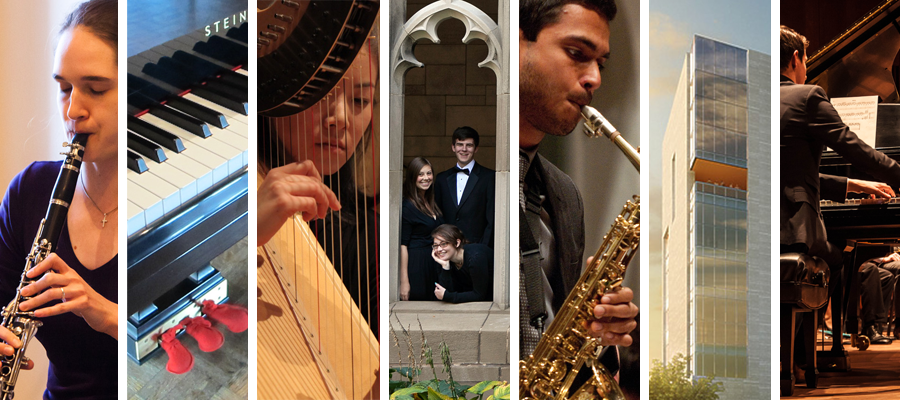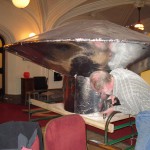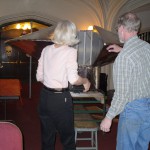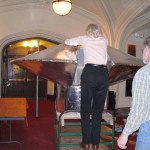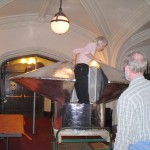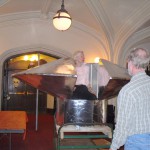Meet Dan McDonald. He has been a community member in the University Symphony Orchestra for almost 40 years. He is also the mastermind behind each of Music Director and Conductor Barbara Schubert’s mysterious grand entrances. In 2009, McDonald created a spaceship for “Cosmic Adventures!” out of refurbished pieces of wood and aluminum foil. (See photos)
This year’s theme is “The Wild, Wild West!” Do you think Maestra Schubert will enter in a covered wagon … or on a bucking horse??
Interview:
Each year, at the start of the annual Halloween concert, Barbara Schubert enters Mandel Hall in full costume and make-up, and is often carried in one way or another, into the hall. One year, for example, she entered while riding on top of a giant shark! It is anyone’s guess how she will make this grand entrance each year… So, as the man behind the engineering of these exciting entrances where do you get your inspiration? How long does it take you to design and make these creations?
I believe that the first entrance down the center aisle was Barbara dressed as Princess Jasmine entering on a flying carpet. Then she was Pocahontas in a canoe, which was built in our kitchen. Some entrances are last minute inspirations, like the coffin we built in the garage the night before the “vampire” concert. Some involve no building or complicated planning. For example is the “Pirates of the Caribbean” concert where I, dressed remarkably like Johnny Depp’s version of Jack Sparrow, chased after the dancers from the Hyde Park School of Ballet and returned with my prize, Barbara, flung over my shoulder. My favorite building project was a flying saucer modeled after the balloon-boy hoax of a few years ago. It had to be built in 5 or 6 pieces in order to get out our basement door. The shark took about two weeks of evenings.
Do you know how the traditions of the annual Halloween Concert came about? When did it begin to have a theme each year? When did it become such a popular event for both students and families in the Hyde Park Community?
The Halloween concerts started in the late seventies. (I believe it was 1979.) At the time we mostly did the typical music associated with Halloween like “Night on Bald Mountain” and “Dance Macabre”. Barbara has never been very excited about repeating pieces of music in fewer than ten or fifteen years. So she started looking for creative ways to do atypical Halloween pieces. Maybe even as early as the second Halloween concert the present format came into being.
Do you have an all-time favorite Halloween Concert theme?
The themes have often been based on popular movies or television shows. I orchestrated the theme music from “Star Trek” for a “Space the Final Frontier” concert. I also did a version of the “Ghostbusters” theme for a concert based on musical ghosts including “The Flying Dutchman” overture. That year the concert ended with the director of the University Chorus and two chorus members doing the Ghostbusters rap.
Collaborations with other arts organizations have been essential in recent years: most notably members of the University Chorus and the Hyde Park School of Ballet [now Hyde Park School of Dance].
At an early stage we even accompanied a Kung-Fu battle between a knife wielding Theseus and a Minotaur by performing Elliot Carter’s “Minotaur Suite.”
As a violist, what is your favorite orchestral repertoire? Does the repertoire in this year’s Halloween concert highlight the string section?
My favorite repertoire is from the late nineteenth and early twentieth centuries. My first musical choice concert was for a “Dangerous Women” theme. The entrance music was lifted from “Batman Returns”. I entered first in full Batman costume. Judging from the applause, I think the audience though it was Barbara. While I started to conduct the orchestra, She entered as Cat Woman with her whip and sent me to the viola section, decowling me in the process. I believe this was the first concert that she narrated entirely in verse. The music include Tchaikovsky’s “Franchesca da Rimini”, Strauss’s “Dance of the Seven Veils”, Barber’s “Medea’s Meditation and Dance of Vengeance”, and Saint-Saëns “Baccanale from Samson and Delila”. All pieces had very scary women and great viola parts.
What do you enjoy most about being a part of the ensemble? How would you say the symphony has grown, or changed over the years?
I’ve been an orchestra member since autumn of 1974, almost 2 years before Barbara first conducted the orchestra. Being a part of any musical ensemble is an excellent example of teamwork, far beyond any sport activity. Everyone must do his or her best practicing, listening, watching, cooperating, and coordinating. One person out of place or out of tune can often ruin the efforts of the other 90 or so players. The level of concentration is a lot like meditation: cleansing for the spirit.
The University of Chicago Symphony has changed dramatically since Barbara started as music director. The number of concerts per year has more than doubled, the size of the string section has nearly doubled, and the quality of the playing has been transfigured. Barbara has challenged the orchestra from the very beginning. Her very first concert included the very difficult Strauss tone poem “Death and Transfiguration.” The University of Chicago students have continued to rise to ever-larger challenges.
Annual Halloween Concert: “The Wild, Wild West!” this Saturday, October 27 at 7 & 9 PM
